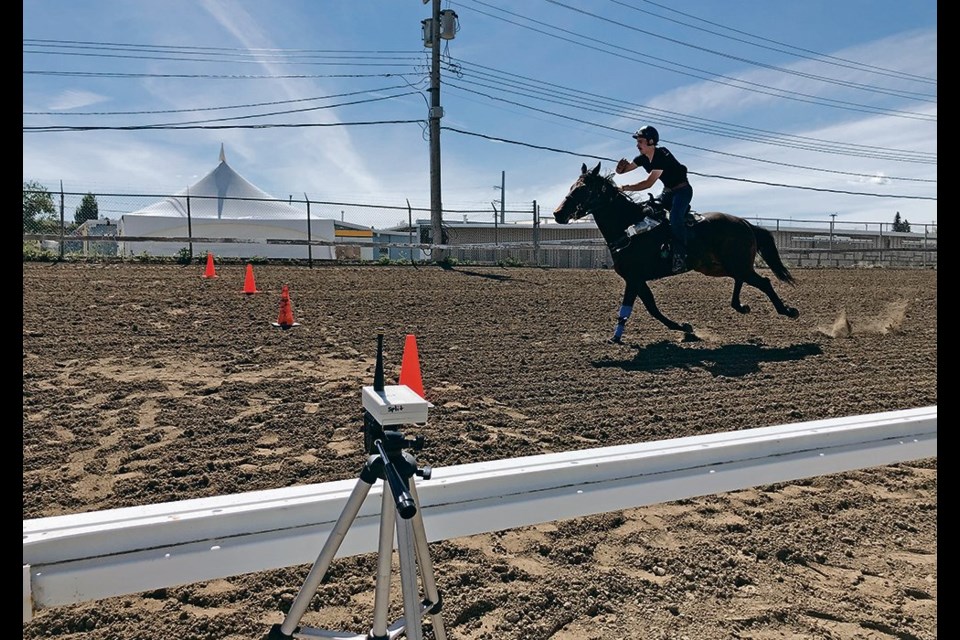WESTERN PRODUCER — A scientist is trying to lower the risk of horses being killed or injured from leg fractures and heart problems during chuckwagon races at the Calgary Stampede.
“We have 550 horses running, and you’re really looking for prevention of the exception — this one horse that’s going to be in trouble there,” said Renaud Leguillette, who is the Calgary chair in Equine Sports Medicine at the University of Calgary’s Faculty of Veterinary Medicine.
“But unfortunately, we all know that when that happens, it has huge consequences, so first of all, the horse will probably have to be put down, and you may have a rider getting hurt. And if you have other horses running into that accident at the same time, you may even have other horses falling and getting hurt.”
Leguillette is part of a team of scientists who took part in research before and during the 10-day Calgary Stampede, which ended July 17. They included W. Brent Edwards, an associate professor in the university’s Faculty of Kinesiology, and Thilo Pfau, a professor in both veterinary medicine and kinesiology.
Although they examined chuckwagon horses, their research could potentially be applied to horses in other rodeo events and to sports involving jumping or racing, said Leguillette. It could also help producers better understand the importance of footing and terrain when they ride horses at speed, he added.
“You have to keep in mind that you want a homogeneous footing … and you want to pay attention to the quality, so the depths and the hardness of the footing becomes even more important as you go faster.”
This year marked the first time the Rangeland Derby chuckwagon races were held since 2019, when six horses died. The COVID-19 pandemic forced cancellation of the Stampede in 2020, and although the Greatest Outdoor Show on Earth returned in 2021, chuckwagon races weren’t held due to safety concerns.
They returned this year under new measures that included reducing the number of competing chuckwagons in each heat to three, down from four. However, one horse had to be euthanized after being injured during a race July 14.
Leguillette said his research partly involved preventing stress fractures or catastrophic failure fractures in the leg bones of chuckwagon horses when the animals are running on the track during races. Such injuries typically occur in the fetlock and first phalanx areas, he said.
“So, basically, you probably have micro cracks … in the bone and then suddenly, either a wrong step or again, too many forces on the bone, and then poof, you have a fracture there.”
Injured horses are usually euthanized because it is typically not possible to repair the damage, he said. Although there are likely many contributing factors to leg fractures, track preparation is one thing that can be controlled. It includes eliminating bad spots by ensuring moisture content and depth of the footing are consistent throughout the track.
However, due to the typical extremes in Alberta weather at the Stampede, which in some years has even included snow in July, coming up with a reliable strategy for every track condition is easier said than done. Leguillette aims to gain insight into the problem by conducting detailed analysis of the legs of chuckwagon horses as they race.
A few weeks before the Stampede began, scientists attached instruments ranging from accelerometers to GPS and inertial sensors on areas of horses’ bodies, ranging from hooves to the cannon and radius bones. The horses ran at full speed under different track conditions.
“And so again, the goal was really to look at, ‘OK, how much those track conditions change really the amplitude or the shock basically to the bones and the joints of those horses?’”
Such changes are likely more exponential than linear, meaning small alterations in the depth of the footing, for example, will potentially have a significant effect on dampening shocks to the legs. However, scientists are still analyzing the results of their research, said Leguillette.
They are also studying how to prevent heart failure in chuckwagon horses by improving detection before each race.
“And again, those are rare, but when they happen, you have a horse collapsing down and so it’s a big issue, for sure.”
The research involves troponin, a protein involved in the contraction of the heart muscle that is released into the blood when cells break down. A blood test developed for humans that is almost 10 times more sensitive than previous methods has been validated for horses, he said.
However, it has not been proven in the field, he added. Researchers are analyzing blood samples obtained from hundreds of chuckwagon horses at this year’s Stampede.
Each time a horse ran for the first time in the evening, blood was pulled about 12 hours later in the morning, said Leguillette.
“And I think that’s going to be the study with the highest number of horses really in the world for this kind of publication.”




